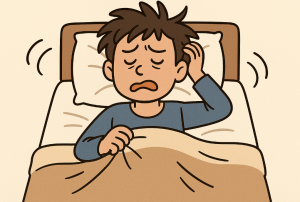
What Really Happens When Insects Sing
Please play the following video while you read this for the full immersive experience.
Every summer, noise complaints spike when cicadas chorus. Yet EEG data now shows single insect calls can lower stress and nudge the brain toward calm. But here’s the twist: turn the volume or pitch up, and your focus slips.
Picture this in everyday terms. A gentle cricket chirp is like a pinch of salt—enough to brighten the dish. Too much, and the meal is ruined. The science here asks a simple but global question: Can small doses of nature’s soundscape help us relax without stealing our attention? Let’s see where the data leads.
In a busy lab in Lagos, a student puts on headphones between pipetting runs. A soft 25–30 dB cricket call helps her unwind before the next protocol step. In Pune, an engineer coding through heat and traffic plays a 900 Hz forest insect track that feels like shade for the mind. In Manaus, a health worker prepping patient charts sips coffee while a low hum from the park outside eases the morning rush. Each scene is ordinary—and that’s the point. The right sound at the right level can make everyday work feel lighter. But here’s where it gets interesting…
The research story
- Alpha (α1, α2): calm, safe, relaxed-alert
- Beta (β1, β2): focused effort, vigilance
- Ratios like β/α and β/(α+θ): proxies for stress and engagement
Two knobs matter most: frequency (how high the pitch is) and amplitude (how loud). The team standardized careful, one-minute clips, then compared brain responses to a quiet baseline. The “aha” moment? Single insect calls—by themselves—tended to lower stress and promote relaxation. But as frequency passed ~1 kHz or loudness rose above ~30 dB, work engagement dropped and attention scattered. We thought “more nature = more benefit”… but the data says dose and tone matter.
Why this matters (especially where resources are tight)
You don’t need a fancy wellness room to try this. Free audio, simple speakers, and a few rules of thumb may help students, clinic staff, or factory teams take micro-breaks that reduce stress—without derailing focus.
- Keep it soft: under ~30 dB (think whisper-quiet).
- Keep it low: below ~1,000 Hz (warmer, less piercing).
- Keep it solo: single-insect tracks beat big summer choruses for calm.
In regions facing heat, crowding, or high cognitive load, these are small knobs you can actually turn. But here’s where it gets interesting…
The bee and the cricket
The study found different insects tug our attention in different ways. Bees (Apoidea) can increase alertness—your brain’s “heads up!” system lights up. That’s useful before a task, like a pre-game warm-up. But ride the buzz too long, and focus frays. Crickets often sound crisp and pleasant, leaning into relaxation—and can still distract if the pitch climbs or the volume creeps up. So the resolution is not “insects are good/bad,” but “match sound to purpose, and watch the levels.” And here’s where it gets interesting…
The pattern was consistent: gentle, lower-pitch calls raised alpha (calm) and reduced β/α (stress). As frequency and loudness rose, engagement measures fell—the brain wandered. We expected all nature sounds to help focus; the data says some soothe while subtly pulling you off task. But here’s where it gets interesting…
People aren’t the same—and that’s useful
The team also saw demographic differences:
- Men vs. women: Men, on average, showed more relaxation to insect calls.
- Undergrads vs. grads: Undergrads leaned more relaxed-alert than grads.
- Rural vs. urban: Rural participants relaxed more readily to these sounds.
Don’t over-read this—no single profile tells the whole story. But it hints at personalization: let people choose between softer cricket tracks, subtler katydid patterns, or even short bee “alertness nudges.” In a mixed office or classroom, give options and let the data (and people) decide. Now here’s where it gets interesting…
From myth to practice
History is full of contradictions about insects: in parts of China, chirping pets were treasured for centuries; in cities worldwide, summer cicadas are labeled “noise.” The EEG adds a modern layer: solitary, low, and soft can be a mental balm. Group, high, and loud can be a focus thief. The lesson is not to silence nature, but to tune it—like choosing shade over glare.
Three quick fixes
- Set the dial: If you use soundscapes at work or school, cap volume near ≤30 dB and aim for <1 kHz tracks.
- Time the buzz: Use 15–60 seconds of bee-like hum to kickstart alertness before a task, then switch to soft, low cricket for sustained calm.
- Let users choose: Offer two or three presets (“Calm Focus,” “Quick Wake-Up,” “Quiet Break”) and check which boosts real performance, not just vibes.
A note of caution you can act on
This study used single-insect clips in controlled settings. Real parks can be messy—many species calling at once, traffic, people, heat. Start small: headphone micro-breaks, short pre-task nudges, or quiet ambient loops in libraries and clinics. Watch outcomes you care about: error rates, reading speed, mood check-ins. The goal isn’t a spa day; it’s tiny, testable gains in calm and clarity.
Let’s Explore Together
- Could a “sound dose” protocol help your class, clinic, or shop floor? What would you test first—volume, pitch, or timing?
- If you built three presets for your team, what would you name them and when would you use each?
- What everyday problem—stress on commutes, jitter before exams, fatigue in night shifts—could careful sound tuning help solve?
If you try this, share what you learn. The next great idea might be as small as a single chirp—and just as powerful.



